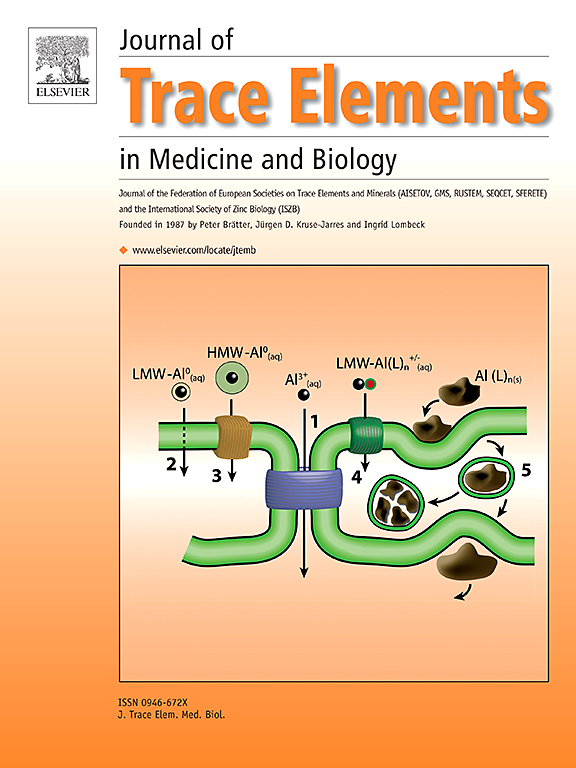多金属暴露与中老年高尿酸血症的关系:中国广西农村的一项横断面研究
IF 3.6
3区 医学
Q2 BIOCHEMISTRY & MOLECULAR BIOLOGY
Journal of Trace Elements in Medicine and Biology
Pub Date : 2025-05-08
DOI:10.1016/j.jtemb.2025.127670
引用次数: 0
摘要
高尿酸血症是一个重要的全球公共卫生问题,特别是在老年人中,并且与金属暴露等环境因素有关。在中国,现有的研究主要集中在城市人口,这使得高尿酸血症与农村人口生态暴露之间的关系没有得到充分的探讨。本研究探讨了中国农村老年居民高尿酸血症与多种金属暴露之间的关系。方法收集2018 - 2019年广西恭城瑶族自治县中老年人群的横断面调查数据。采用的分析技术包括最小绝对收缩和选择算子(LASSO)回归、二元逻辑回归和贝叶斯核机回归(BKMR)来研究暴露于多种金属混合物与高尿酸血症之间的关系。结果logistic回归结果显示,镁与高尿酸血症呈负相关(OR=0.634, 95 % CI=0.476‐0.867,Q3),而铁、镍、锶、钼、锡与高尿酸血症呈正相关(P均为 <; 0.05)。贝叶斯核机回归分析显示,高尿酸血症与血浆多金属混合物之间存在显著的整体正相关,其中Sr (PIP=0.991)和Fe (PIP=0.749)的贡献显著,特别是当所有金属都在各自的第50百分位数时。暴露-反应关系与logistic回归结果一致。血浆Sr与不同水平其他金属的高尿酸血症呈正相关(p25, p50, p75)。结论多金属混合物暴露与高尿酸血症呈正相关,其中锶和铁是最重要的影响因素。本文章由计算机程序翻译,如有差异,请以英文原文为准。
Association of multi-metal exposure with hyperuricemia in middle-aged and older adults: A cross-sectional study in rural Guangxi, China
Background
Hyperuricemia constitutes a significant global public health concern, particularly among the elderly, and is associated with environmental factors such as metal exposure. In China, the predominant focus of existing research has been on urban populations, which leaves the relationship between hyperuricemia and ecological exposures in rural populations inadequately explored. This study investigates the association between hyperuricemia and exposure to multiple metals among elderly residents in rural China.
Methods
Cross-sectional survey data were collected from middle-aged and elderly individuals residing in Yao Autonomous County of Gongcheng, Guangxi, China, from 2018 to 2019. The analytical techniques employed included least absolute shrinkage and selection operator (LASSO) regression, binary logistic regression and Bayesian kernel machine regression (BKMR) to examine the association between exposure to multi-metal mixtures and hyperuricemia.
Results
Logistic regression results indicated a negative association between magnesium (OR=0.634, 95 % CI=0.476‐0.867, Q3) and hyperuricemia, while iron, nickel, strontium, molybdenum, and tin were positively associated with hyperuricemia (all P < 0.05). The Bayesian kernel machine regression analysis revealed a significant overall positive correlation between hyperuricemia and plasma polymetallic mixtures, with notable contributions from Sr (PIP=0.991) and Fe (PIP=0.749), particularly when all metals were at their respective 50th percentiles. Exposure-response relationships were consistent with the logistic regression results. Plasma Sr was positively correlated with hyperuricemia at different levels of other metals (p25, p50, p75).
Conclusion
This study suggests that exposure to multi-metal mixtures is positively associated with hyperuricemia, with Sr and Fe being the most significant contributors.
求助全文
通过发布文献求助,成功后即可免费获取论文全文。
去求助
来源期刊
CiteScore
6.60
自引率
2.90%
发文量
202
审稿时长
85 days
期刊介绍:
The journal provides the reader with a thorough description of theoretical and applied aspects of trace elements in medicine and biology and is devoted to the advancement of scientific knowledge about trace elements and trace element species. Trace elements play essential roles in the maintenance of physiological processes. During the last decades there has been a great deal of scientific investigation about the function and binding of trace elements. The Journal of Trace Elements in Medicine and Biology focuses on the description and dissemination of scientific results concerning the role of trace elements with respect to their mode of action in health and disease and nutritional importance. Progress in the knowledge of the biological role of trace elements depends, however, on advances in trace elements chemistry. Thus the Journal of Trace Elements in Medicine and Biology will include only those papers that base their results on proven analytical methods.
Also, we only publish those articles in which the quality assurance regarding the execution of experiments and achievement of results is guaranteed.

 求助内容:
求助内容: 应助结果提醒方式:
应助结果提醒方式:


